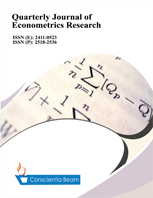Twin Deficit Hypothesis and Macroeconomic Fundamentals: New Evidence from Nigeria
DOI:
https://doi.org/10.18488/journal.88.2021.71.1.12Abstract
This study tests for the validity of the twin-deficit hypothesis in Nigeria for the period 1981 – 2018 and further seeks to ascertain the role of macroeconomic fundamentals in driving this hypothesis using the non-linear autoregressive distributed lag (NARDL) model and structural vector autoregressive (SVAR) model. With evidence from granger causality test, the results obtained for the NARDL model support the validation of the twin-deficit hypothesis for the Nigerian economy. As long-run equilibrium exists, it was further established that the twin deficits were majorly driven by the degrees of financial and trade openness in Nigeria as no substantial shock effects of the twin deficits were traceable to any of the macroeconomic fundamentals. It is therefore recommended that policy makers in Nigeria should properly sequence the degree of economic openness to ensure the overall health of the economy.

